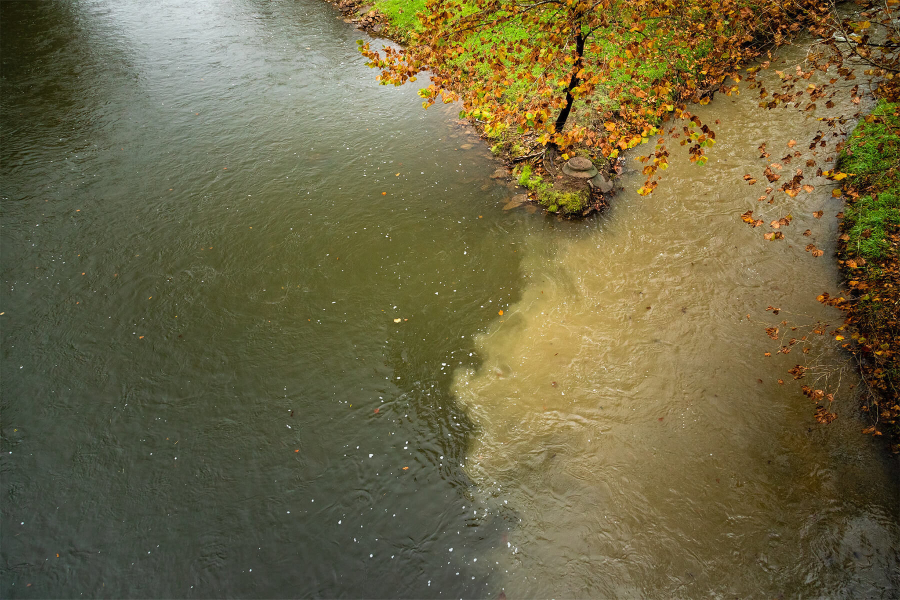What are the main sources of pollution to the Chesapeake Bay?
The three main sources of pollution to the Chesapeake Bay are nitrogen, phosphorus and sediment.

In our effort to improve water quality in the Chesapeake Bay, there are three sources of pollution that we try to contain: nitrogen, phosphorus and sediment.
Nitrogen and phosphorus are both nutrients, which cause harm to the Bay marine life by creating algae blooms. Nutrients help make things grow (which is why they're used on farms) but when they enter the water in too high amounts they cause algae to grow too quickly. These "algae blooms" block sunlight from reaching plants that grow in the water, which they need to survive. Algae blooms also die off quickly, which sucks oxygen out of the water and creates areas of little-to-no oxygen called dead zones.
The third pollutant—sediment—include loose particles of clay, silt and sand that wash into the water. Sediment is bad because it makes the water cloudy (imagine filling a bath tub with dirt) which blocks the sunlight from reaching plants, causing them to die. As sediment settles to the bottom of the Bay and its rivers, it smothers bottom-dwelling animals (such as oysters). Sediment can also carry high concentrations of phosphorus and toxic chemicals.
Now that you know the three main sources of pollution (nitrogen, phosphorus and sediment) it helps to also know where these pollutants come from. At the Chesapeake Bay Program, we track sources of nitrogen, phosphorus and sediment every year so that we can know exactly what's threatening the Bay.
Nitrogen
Nitrogen occurs naturally in soil, animal waste, plant material and the atmosphere. However, most of the nitrogen delivered to the Bay comes from:
- Manure, emissions and chemical fertilizers from farmland and animal operations (48%)
- Nitrogen oxide emissions from sources including vehicles, industries and electric utilities (7%
- Human waste treated and discharged from municipal wastewater treatment plants and wastewater discharged from industrial facilities (12.4%)
- Chemical fertilizers applied to lawns, golf courses and other developed lands (16.6%)
- Septic systems that treat household wastewater and discharge effluent to groundwater in the Bay watershed (3.25%)
Phosphorus
The majority of phosphorous entering the Chesapeake Bay comes from natural sources, such as soil, animal waste and plant material. The three other major sources of phosphorous pollution are:
- Manure, emissions and chemical fertilizers from farmland and animal operations (27.7%)
- Chemical fertilizers applied to lawns, golf courses and other developed lands (17.9%)
- Human waste treated and discharged from municipal wastewater treatment plants and wastewater discharged from industrial facilities (15.7%)
Sediment
While the majority of sediment pollution occurs naturally (81%), there are three other sources that we track:
- Loose soil and fertilizer used throughout suburban and urban areas (9.48%)
- Soil, fertilizer and eroding stream banks on agricultural property (8.7%)
- Human waste treated and discharged from municipal wastewater treatment plants and wastewater discharged from industrial facilities (.25%)
What can you do to help?
While some sources of pollution may be larger than others, one source is not more important to prevent than any other. We must take any and all steps to reduce nitrogen, phosphorous and sediment loads to the Bay. Think about how your daily actions contribute pollution to the Bay and its rivers. Be sure to check out our Help Protect the Bay tips to learn how you can do your part.

Comments
Hi Jasmine,
About half of the water in the Chesapeake Bay is salt water, coming from the Atlantic Ocean. The other half is fresh water -- half of that fresh water comes from the Susquehanna River, the Bay's largest tributary. For more facts and figures about the Bay, please visit our website: https://www.chesapeakebay.net/discover/facts
Thanks,
Rachel
From which source does most of our water in the watershed come from?
(chesapeake bay watershed)
Hi Margaret,
The three biggest pollutants entering the Chesapeake Bay are nitrogen, phosphorus and sediment. There are a variety of reasons why these pollutants enter the Bay, including agricultural runoff, wastewater treatment plants, air pollution and urban and suburban runoff (e.g. stormwater). Agricultural runoff is the number one source of pollution into the Bay. For more information, please visit our Learn the Issues page on Nutrients (https://www.chesapeakebay.net/issues/nutrients) or you can view specific charts with this information on ChesapeakeProgress (http://www.chesapeakeprogress.com/clean-water/watershed-implementation-plans).
Thanks,
Rachel
What are the 2 major pollutants causing issues in the Bay?, What is the major source of these sources?
Great, thanks. One more question how do these pollutants harm the dwellers of the bay (plants and animals)? Thanks.
Thank you!
Your comment has been received. Before it can be published, the comment will be reviewed by our team to ensure it adheres with our rules of engagement.
Back to recent stories